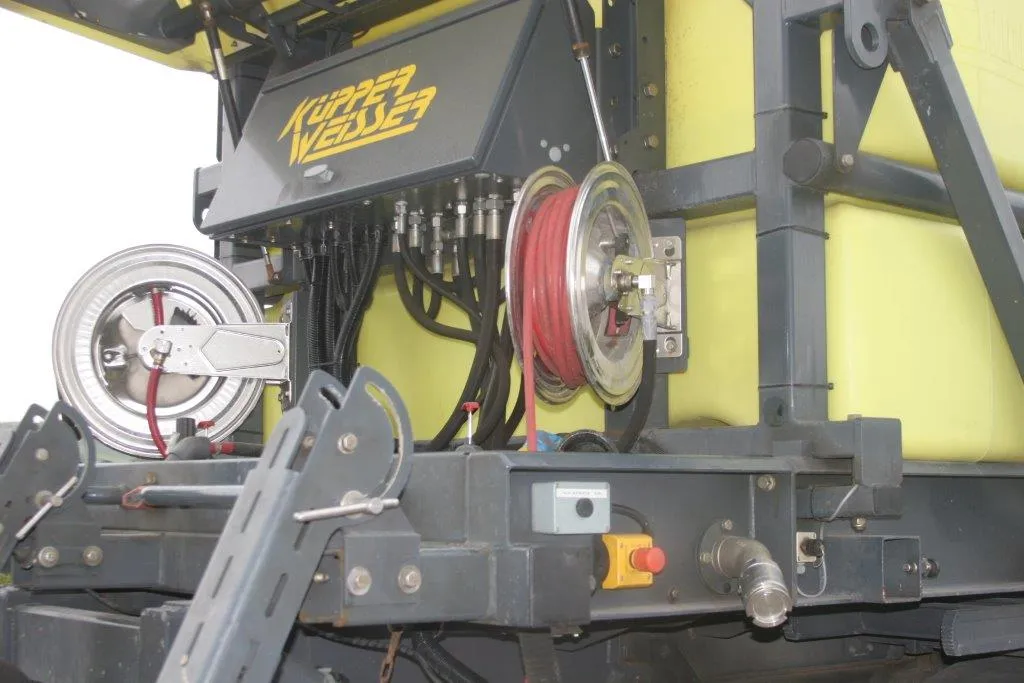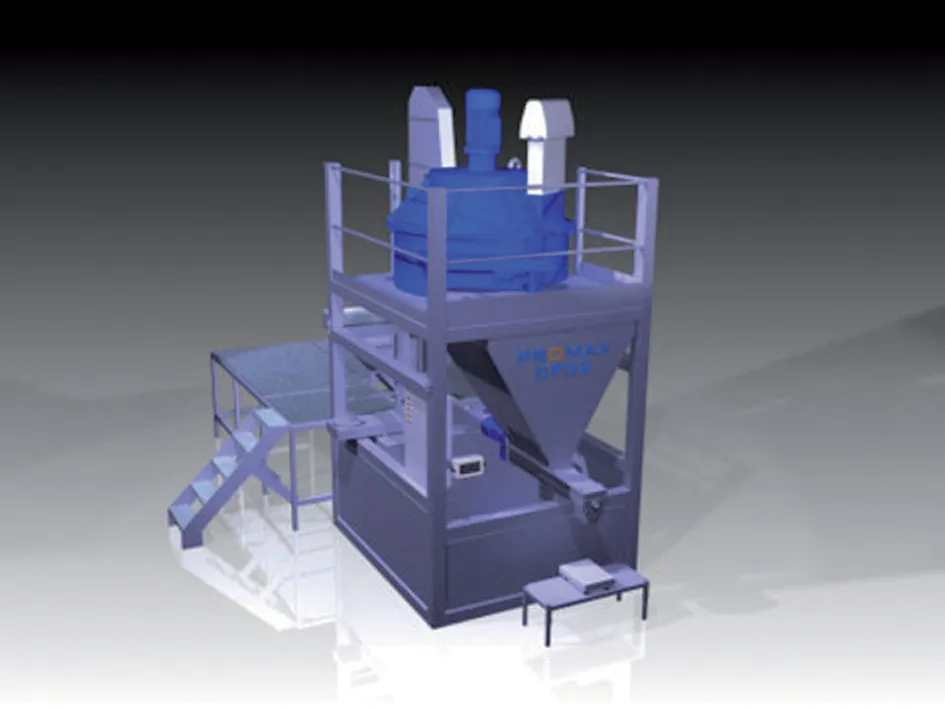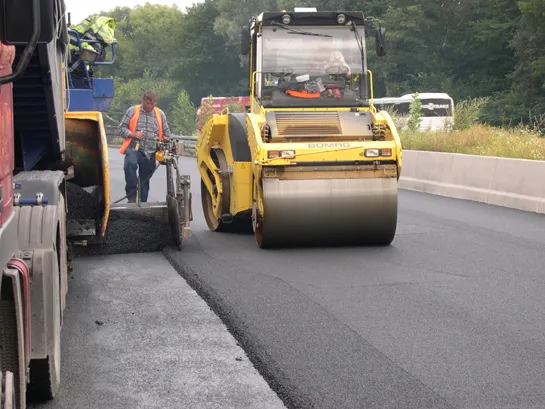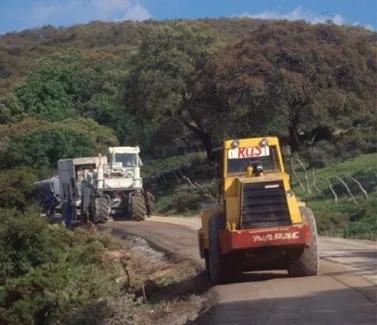The stone mastic asphalt surface being laid on the bridge deck. The Stonecutters Bridge in Hong Kong, the second longest spanning cable stayed bridge in the world, is a dual three-lane crossing of the Rambler Channel. It utilises 33,500tonnes of structural steel in the bridge deck; 32,000m3 of concrete in the towers and 65 steel deck units relying on 224 cables. Effectively protecting the megastructure's deck from the weather extremes (monsoon rains and extreme heat in the summer) and the high levels of tra
February 6, 2012
Read time: 4 mins
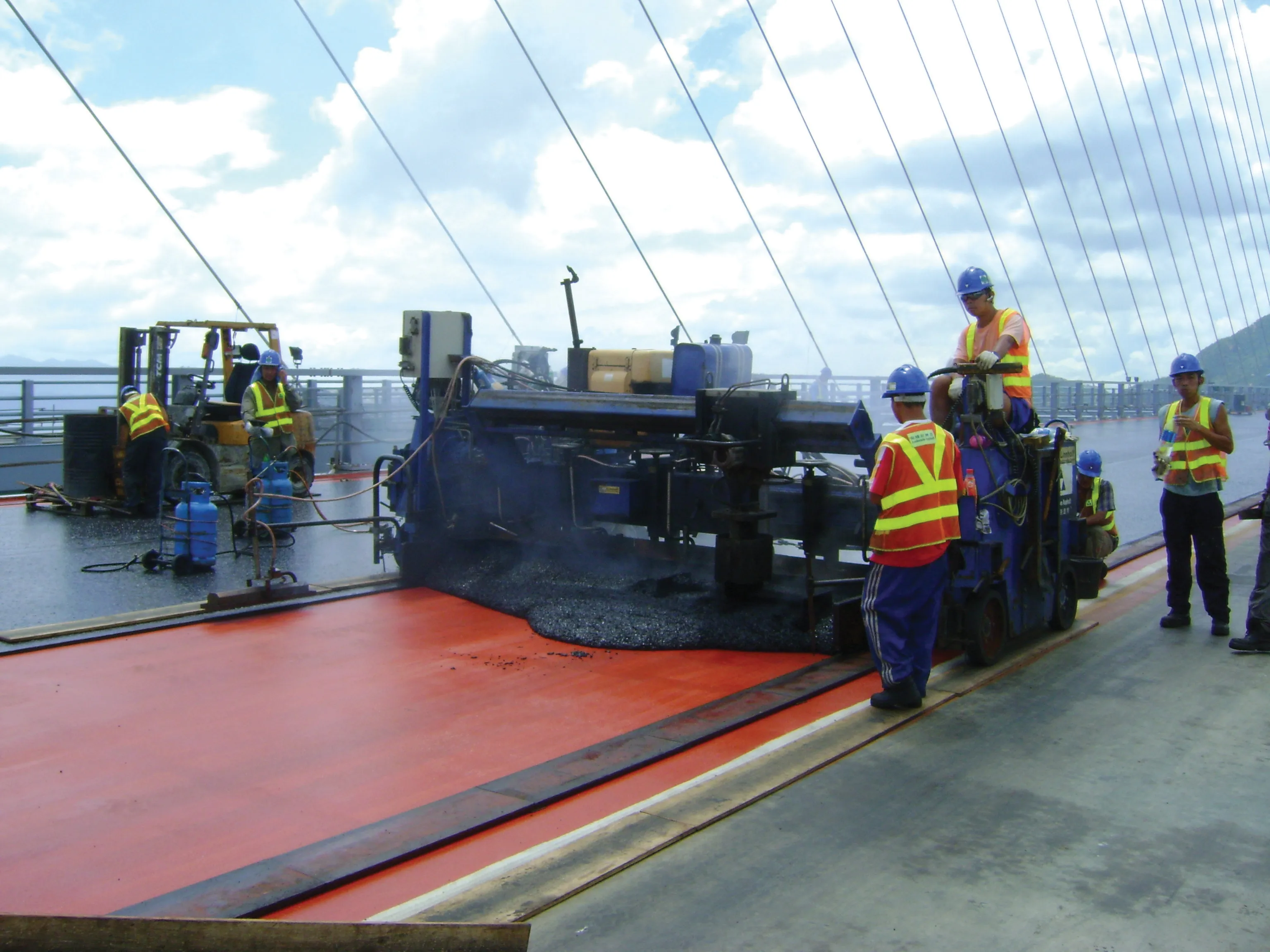
The stone mastic asphalt surface being laid on the bridge deck
The Stonecutters Bridge in Hong Kong, the second longest spanning cable stayed bridge in the world, is a dual three-lane crossing of the Rambler Channel. It utilises 33,500tonnes of structural steel in the bridge deck; 32,000m3 of concrete in the towers and 65 steel deck units relying on 224 cables.
Effectively protecting the megastructure's deck from the weather extremes (monsoon rains and extreme heat in the summer) and the high levels of traffic from2308 Chek Lap Kok Airport and the region's container port was essential.
Main contractor Maeda Hitachi Yokogawa Hsin Chong JV and designers Ove Arup and Partners HK turned to2314 Stirling Lloyd Polychem and its Eliminator two-coat, colour-coded methylmethacrylate (MMA)-based system, which for the last 15 years has been used to protect all new steel highway bridges in Hong Kong.
Mehrdad Paykazadi, Stirling Lloyd's sales manager for Hong Kong, said: "Eliminator's track record of performing in higher temperatures as well as its conformance to the Bridge Deck Waterproofing Standard BD47 meant it met the strict criteria for the Stonecutters' project and led to its use on this immense structure." As is common in Hong Kong the deck surfacing was stone mastic asphalt (SMA), which helps to reduce noise and dissipate water from the surface. The surfacing specification called for a mastic asphalt intermediary layer between the waterproofing system and the SMA. To confirm that Eliminator could achieve the specified tensile and shear adhesion strengths to the mastic asphalt, an extensive programme of pre-construction testing was carried out.
The deck was captive blasted and tensile adhesion tests were carried out to assess the bond that would be achieved between the deck and the waterproofing. The design specification required a minimum bond of 2MPa: adhesion tests gave results of between 5-6MPa.
The deck was then primed with Stirling Lloyd's anti-corrosive ZED S94 primer, which protected it and enhanced the bond between the deck and subsequent membrane.
Stirling Lloyd's authorised contractor2310 Advance Specialist Treatment Engineering, awarded the contract for installing the waterproofing, then spray applied the first yellow pigmented coat of the Eliminator membrane to the deck. Cold liquid applied, this gave a seamless membrane with no vulnerable laps or joints. After curing (in under an hour) the second coat, pigmented grey, was spray applied: a total of some 47,500m2 of Eliminator was applied to the deck in the main carriageway.
The contrasting colours helped the sprayer to ensure that the specified thickness was being applied, and this visual check was backed up by regular wet film thickness tests.
Stirling Lloyd's Tack Coat No. 2 was roller applied onto the Eliminator membrane to enhance the bond between the waterproofing and the SMA: once this had dried the system was ready to be surfaced.
"Throughout the laying of the surfacing adhesion tests, designed by Arup, were undertaken which confirmed that the high adhesion values between the waterproofing and surfacing achieved in the pre-construction testing were being realised on site," says Stirling Lloyd.
Some 5,000m2 of Stirling Lloyd's lightweight waterproofing and wearing course system Bridgemaster was used to treat the outer edges of the decks, which required an effective waterproofing system that incorporated an anti-skid surface. The system's resin element, which contains aggregate fillers, was spread across the area, and while still in a liquid state a final aggregate overscatter was broadcast to provide the skid resistance.
As the bridge comprises two decks (one for carrying airport traffic, the other Hong Kong-bound vehicles) with a 14m wide gap between them, a waterproof solution to allow rainwater to run off the decks and into the Rambler Channel was required. Stirling Lloyd's rapid hardening Metaset Concrete, a material based on the MMA technology used in Eliminator and Bridgemaster, was used to create a triangular shape with the thick end of the wedge meeting the deck, ensuring that water travels away from the deck.
The Stonecutters Bridge in Hong Kong, the second longest spanning cable stayed bridge in the world, is a dual three-lane crossing of the Rambler Channel. It utilises 33,500tonnes of structural steel in the bridge deck; 32,000m3 of concrete in the towers and 65 steel deck units relying on 224 cables.
Effectively protecting the megastructure's deck from the weather extremes (monsoon rains and extreme heat in the summer) and the high levels of traffic from
Main contractor Maeda Hitachi Yokogawa Hsin Chong JV and designers Ove Arup and Partners HK turned to
Mehrdad Paykazadi, Stirling Lloyd's sales manager for Hong Kong, said: "Eliminator's track record of performing in higher temperatures as well as its conformance to the Bridge Deck Waterproofing Standard BD47 meant it met the strict criteria for the Stonecutters' project and led to its use on this immense structure." As is common in Hong Kong the deck surfacing was stone mastic asphalt (SMA), which helps to reduce noise and dissipate water from the surface. The surfacing specification called for a mastic asphalt intermediary layer between the waterproofing system and the SMA. To confirm that Eliminator could achieve the specified tensile and shear adhesion strengths to the mastic asphalt, an extensive programme of pre-construction testing was carried out.
The deck was captive blasted and tensile adhesion tests were carried out to assess the bond that would be achieved between the deck and the waterproofing. The design specification required a minimum bond of 2MPa: adhesion tests gave results of between 5-6MPa.
The deck was then primed with Stirling Lloyd's anti-corrosive ZED S94 primer, which protected it and enhanced the bond between the deck and subsequent membrane.
Stirling Lloyd's authorised contractor
The contrasting colours helped the sprayer to ensure that the specified thickness was being applied, and this visual check was backed up by regular wet film thickness tests.
Stirling Lloyd's Tack Coat No. 2 was roller applied onto the Eliminator membrane to enhance the bond between the waterproofing and the SMA: once this had dried the system was ready to be surfaced.
"Throughout the laying of the surfacing adhesion tests, designed by Arup, were undertaken which confirmed that the high adhesion values between the waterproofing and surfacing achieved in the pre-construction testing were being realised on site," says Stirling Lloyd.
Some 5,000m2 of Stirling Lloyd's lightweight waterproofing and wearing course system Bridgemaster was used to treat the outer edges of the decks, which required an effective waterproofing system that incorporated an anti-skid surface. The system's resin element, which contains aggregate fillers, was spread across the area, and while still in a liquid state a final aggregate overscatter was broadcast to provide the skid resistance.
As the bridge comprises two decks (one for carrying airport traffic, the other Hong Kong-bound vehicles) with a 14m wide gap between them, a waterproof solution to allow rainwater to run off the decks and into the Rambler Channel was required. Stirling Lloyd's rapid hardening Metaset Concrete, a material based on the MMA technology used in Eliminator and Bridgemaster, was used to create a triangular shape with the thick end of the wedge meeting the deck, ensuring that water travels away from the deck.


